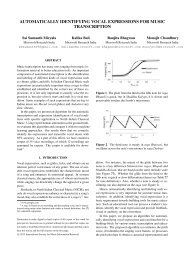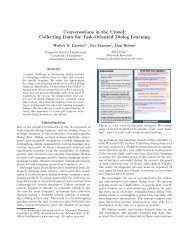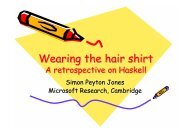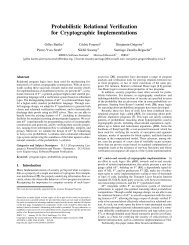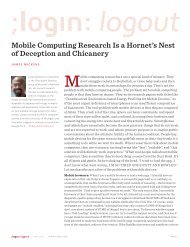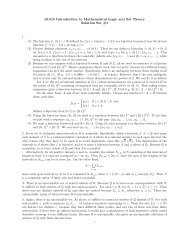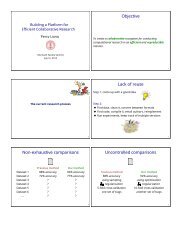A Moving Target—The Evolution of Human-Computer Interaction
A Moving Target—The Evolution of Human-Computer Interaction
A Moving Target—The Evolution of Human-Computer Interaction
You also want an ePaper? Increase the reach of your titles
YUMPU automatically turns print PDFs into web optimized ePapers that Google loves.
<strong>of</strong> interaction to explore and new practices to improve. The first generation <strong>of</strong> computer researchers, designers, and<br />
users grew up without computers. The generation that followed used computers as students, entered workplaces,<br />
and changed the way technology was used. Now a generation has grown up with computers, game consoles, and<br />
cell phones. They absorbed an aesthetic <strong>of</strong> technology design and communicate by messaging. They are developing<br />
skills at searching, browsing, assessing, and synthesizing information. They use smartphones, acquire multimedia<br />
authoring talent, and embrace social networking sites. They have different takes on privacy and multitasking. They<br />
are entering workplaces, and everything will be changed once again. However it is defined and wherever it is studied,<br />
human–computer interaction will for some time be in its early days.<br />
APPENDIX: PERSONAL OBSERVATIONS<br />
My career from 1973 to 1993 followed a common enough path. I was one <strong>of</strong> many who worked as a computer programmer,<br />
studied cognitive psychology, spent time as an HCI pr<strong>of</strong>essional in industry, and then moved to academia. I<br />
describe personal experiences here not because I am special, but to add texture and a sense <strong>of</strong> the human impact <strong>of</strong><br />
some <strong>of</strong> the developments I have described. My interest in history arose from the feeling <strong>of</strong> being swept along by<br />
invisible forces, sometimes against my intention. My first effort at understanding was titled “The <strong>Computer</strong> Reaches<br />
Out” (Grudin, 1990) because I saw computers evolving and slowly reaching into the world and changing it in ways<br />
that we, their developers, had not foreseen.<br />
1970: A Change in Plans. As a student, I read and believed the Life magazine article that forecasted computers with<br />
super-human intelligence arriving in several years. I concluded that if we survived a few years, we could count on<br />
machines to do all useful work. <strong>Human</strong> beings should focus on doing what they enjoy. I shifted from physics to mathematics<br />
and from politics to literature.<br />
1973: Three Pr<strong>of</strong>essions. Looking for my first job in 1973, I found three computer job categories in the Boston Globe<br />
classifieds: (i) operators, (2) programmers, and (3) systems analysts. Not qualified to be a highly paid analyst, I considered<br />
low-paid, hands-on operator jobs but I landed a programming job with Wang Laboratories, which was at the<br />
time a small electronics company. For two years, I never saw the computer that my programs ran on. I flowcharted on<br />
paper and coded on coding sheets that a secretary sent to be punched and verified. A van carried the stack <strong>of</strong> cards<br />
20 miles to a computer center, and later that day or the next day I got the printout. It might say something like “Error<br />
in Line 20,” and I would resume work on the program.<br />
1975: A Cadre <strong>of</strong> Discretionary Hand-On Users. In 1975, Wang acquired a few teletype terminals with access to the<br />
WYLBUR line editor, developed at the Stanford Linear Accelerator. Some <strong>of</strong> us programmers chose to abandon paper<br />
and became hands-on computer users.<br />
1983: Chilly Reception for a Paper on Discretion in Use. My first HCI publication, Grudin & MacLean (1984), was written<br />
when I was a postdoc at the MRC Applied Psychology Unit. Allan and I showed that people sometimes choose a<br />
slower interface for aesthetic or other reasons even when they are familiar with a more efficient alternative. A senior<br />
colleague asked us not to publish it. He worked on improving expert efficiency through cognitive modeling. A demonstration<br />
that greater efficiency could be undesirable would be a distraction, he said: “Sometimes the larger enterprise<br />
is more important than a small study.”<br />
1984: Encountering Moore's Law, Information Systems, <strong>Human</strong> Factors, and Design. I returned to Wang, which had<br />
become a large minicomputer company, and found that Moore's law had changed the business. Hardware was now<br />
<strong>of</strong>ten ordered from catalogs and the reduced cost <strong>of</strong> memory contributed to changing the priorities and skills <strong>of</strong> programming.<br />
I was soon influenced by another cognitive psychologist, Susan Ehrlich, who worked in a marketing research<br />
group and later managed the human factors group. She introduced me to the IS literature, which I found difficult<br />
to understand. I attended Boston-area chapter meetings <strong>of</strong> both HFS and SIGCHI. I saw the cultural differences<br />
but felt CHI could learn from human factors. In a futile gesture to counter CHI antipathy toward human factors, I began<br />
calling myself a human factors engineer. I drove to Cambridge to see the newly released Macintosh. Few s<strong>of</strong>tware<br />
engineers had the visual design skills that I realized would become important, so at work I looked for industrial<br />
designers <strong>of</strong> hardware ('boxes') who could be enlisted to support s<strong>of</strong>tware interface design.<br />
1985: The GUI Shock. In the early 1980s, Phil Barnard and I were among the many cognitive psychologists working on<br />
command naming. This was an important application in the era <strong>of</strong> command-line interfaces, but the ambition was to develop<br />
a comprehensive theoretical foundation for HCI. The success <strong>of</strong> the Mac in 1985 curtailed interest in command<br />
34



